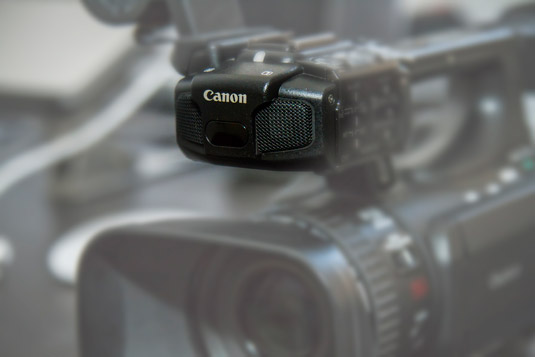Nearly all digital camcorders now have built-in microphones called onboard microphones. On the latest cameras, onboard microphones are better than they used to be, but they’re still not the best solution for recording audio or dialogue in film. Still, at the moment an onboard microphone may be your only solution, so it’s good to know how to get the best results from the on‐board microphone on your camera.

Onboard microphones can be useful for some projects where you may not have room for an external microphone or boom pole. Recording sound with a camera‐mounted microphone isn’t easy, but try using the following techniques to get the best sound:
Get close: To get the highest quality sound, try to get your microphone as close to your subject or character as possible. Sometimes this isn’t easy, especially if you are shooting a wide shot, but you may be able to use the sound recorded in the close‐up shot or mid shot from the same scene.
Having a microphone built into the camera makes it even harder than usual to get the microphone as close as possible to your subject, and you may have to ask your actors to speak clearly and to project their voices. Another option is to turn the level of the microphone on your camera up, but this only increases the overall volume, including background noise.
Reduce camera noise: With onboard‐sound recording, you’re more likely to record noise from the camera itself. Such noise may be from the electronics inside the camera, especially when zooming in and out, or it may come from the sounds you make when pressing buttons or handling the camera while recording.
The best way to avoid these noises is to try not to move your hands too much or press buttons when recording. Mounting your camera on a tripod ensures you don’t have to hold or touch the camera as it’s recording, which helps to reduce any noises made by your hands.
Reduce background noise: It’s not easy to control the noises around you when you’re filming, especially if you’re filming in a public place, such as a park or street. Big‐movie film directors can afford to close roads and public places to control noise, but you won’t be able to.
Onboard microphones tend to pick up background noises even more often than external microphones, so it’s important to try and reduce the amount of noise around you when filming to make it easier for your audience to hear your actors. Before you start filming, ask your cast and crew to be quiet for a few minutes so you can detect any background noises that may cause problems when recording.
To avoid unwanted background noises when filming, ask your crew to keep quiet. Microphones can be very sensitive and may pick up noises that you may not hear. You’ll only notice these noises when you import your footage at the editing stage. Ask your crew to keep still, too, because even gentle footsteps may be picked up by the microphone.

